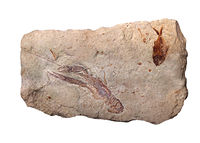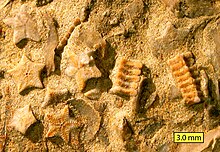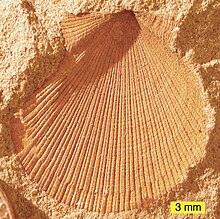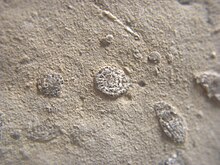
| Home | Sources Directory | News Releases | Calendar | Articles | | Contact | |
Fossil


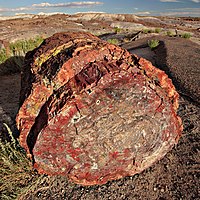
Fossils (from Latin fossus, literally "having been dug up") are the preserved remains or traces of animals, plants, and other organisms from the remote past. The totality of fossils, both discovered and undiscovered, and their placement in fossiliferous (fossil-containing) rock formations and sedimentary layers (strata) is known as the fossil record. The study of fossils across geological time, how they were formed, and the evolutionary relationships between taxa (phylogeny) are some of the most important functions of the science of paleontology. Such a preserved specimen is called a "fossil" if it is older than some minimum age, most often the arbitrary date of 10,000 years ago.[1]
Hence, fossils range in age from the youngest at the start of the Holocene Epoch to the oldest from the Archaean Eon several billion years old. The observations that certain fossils were associated with certain rock strata led early geologists to recognize a geological timescale in the 19th century. The development of radiometric dating techniques in the early 20th century allowed geologists to determine the numerical or "absolute" age of the various strata and thereby the included fossils.
Like extant organisms, fossils vary in size from microscopic, such as single bacterial cells [2] only one micrometer in diameter, to gigantic, such as dinosaurs and trees many meters long and weighing many tons. A fossil normally preserves only a portion of the deceased organism, usually that portion that was partially mineralized during life, such as the bones and teeth of vertebrates, or the chitinous or calcareous exoskeletons of invertebrates. Preservation of soft tissues is rare in the fossil record. Fossils may also consist of the marks left behind by the organism while it was alive, such as the footprint or feces (coprolites) of a reptile. These types of fossil are called trace fossils (or ichnofossils), as opposed to body fossils. Finally, past life leaves some markers that cannot be seen but can be detected in the form of biochemical signals; these are known as chemofossils or biomarkers.
Places of exceptional fossilization
Fossil sites with exceptional preservation ' sometimes including preserved soft tissues ' are known as Lagerstätten. These formations may have resulted from carcass burial in an anoxic environment with minimal bacteria, thus delaying decomposition. Lagerstätten span geological time from the Cambrian period to the present. Worldwide, some of the best examples of near-perfect fossilization are the Cambrian Maotianshan shales and Burgess Shale, the Devonian Hunsrück Slates, the Jurassic Solnhofen limestone, and the Carboniferous Mazon Creek localities.
Earliest fossiliferous sites
Earth's oldest fossils are the stromatolites consisting of rock built from layer upon layer of sediment and other precipitants.[3] Based on studies of now-rare (but living) stromatolites (specifically, certain blue-green bacteria), the growth of fossil stromatolitic structures was biogenetically mediated by mats of microorganisms through their entrapment of sediments. However, abiotic mechanisms for stromatolitic growth are also known, leading to a decades-long and sometimes-contentious scientific debate regarding biogenesis of certain formations, especially those from the lower to middle Archaean eon.
It is most widely accepted that stromatolites from the late Archaean and through the middle Proterozoic eon were mostly formed by massive colonies of cyanobacteria (formerly known as blue-green "algae"), and that the oxygen byproduct of their photosynthetic metabolism first resulted in earth's massive banded iron formations and subsequently oxygenated earth's atmosphere.
Even though it is extremely rare, microstructures resembling cells are sometimes found within stromatolites; but these are also the source of scientific contention. The Gunflint Chert contains abundant microfossils widely accepted as a diverse consortium of 2.0 Ga microbes.[4]
In contrast, putative fossil cyanobacteria cells from the 3.4 Ga Warrawoona Group in Western Australia are in dispute since abiotic processes cannot be ruled out.[5] Confirmation of the Warrawoona microstructures as cyanobacteria would profoundly impact our understanding of when and how early life diversified, pushing important evolutionary milestones further back in time. The continued study of these oldest fossils is paramount to calibrate complementary molecular phylogenetics models.
Developments in interpretation of the fossil record
Ever since recorded history began, and probably before, people have noticed and gathered fossils, including pieces of rock and minerals that have replaced the remains of biologic organisms, or preserved their external form. Fossils themselves, and the totality of their occurrence within the sequence of Earth's rock strata, is referred to as the fossil record.
The fossil record was one of the early sources of data relevant to the study of evolution and continues to be relevant to the history of life on Earth. Paleontologists examine the fossil record in order to understand the process of evolution and the way particular species have evolved.
Explanations
Various explanations have been put forth throughout history to explain what fossils are and how they came to be where they were found. Many of these explanations relied on folktales or mythologies. In China the fossil bones of ancient mammals including Homo erectus were often mistaken for 'dragon bones' and used as medicine and aphrodisiacs. In the West the presence of fossilized sea creatures high up on mountainsides was seen as proof of the biblical deluge.
Greek scholar Aristotle realized that fossil seashells from rocks were similar to those found on the beach, indicating the fossils were once living animals. Leonardo da Vinci concurred with Aristotle's view that fossils were the remains of ancient life.[6] In 1027, the Persian geologist, Ibn Sina (known as Avicenna in Europe), explained how the stoniness of fossils was caused in The Book of Healing. However, he rejected the explanation of fossils as organic remains.[7] Aristotle previously explained it in terms of vaporous exhalations, which Ibn Sina modified into the theory of petrifying fluids (succus lapidificatus), which was elaborated on by Albert of Saxony in the 14th century and accepted in some form by most naturalists by the 16th century.[8] Ibn Sina gave the following explanation for the origin of fossils from the petrifaction of plants and animals:
If what is said concerning the petrifaction of animals and plants is true, the cause of this (phenomenon) is a powerful mineralizing and petrifying virtue which arises in certain stony spots, or emanates suddenly from the earth during earthquake and subsidences, and petrifies whatever comes into contact with it. As a matter of fact, the petrifaction of the bodies of plants and animals is not more extraordinary than the transformation of waters.[9]
More scientific views of fossils emerged during the Renaissance. For example, Leonardo Da Vinci noticed discrepancies with the use of the biblical flood narrative as an explanation for fossil origins:
"If the Deluge had carried the shells for distances of three and four hundred miles from the sea it would have carried them mixed with various other natural objects all heaped up together; but even at such distances from the sea we see the oysters all together and also the shellfish and the cuttlefish and all the other shells which congregate together, found all together dead; and the solitary shells are found apart from one another as we see them every day on the sea-shores.
And we find oysters together in very large families, among which some may be seen with their shells still joined together, indicating that they were left there by the sea and that they were still living when the strait of Gibraltar was cut through. In the mountains of Parma and Piacenza multitudes of shells and corals with holes may be seen still sticking to the rocks..."[10]
William Smith (1769-1839), an English canal engineer, observed that rocks of different ages (based on the law of superposition) preserved different assemblages of fossils, and that these assemblages succeeded one another in a regular and determinable order. He observed that rocks from distant locations could be correlated based on the fossils they contained. He termed this the principle of faunal succession.
Smith, who preceded Charles Darwin, was unaware of biological evolution and did not know why faunal succession occurred. Biological evolution explains why faunal succession exists: as different organisms evolve, change and go extinct, they leave behind fossils. Faunal succession was one of the chief pieces of evidence cited by Darwin that biological evolution had occurred.
Georges Cuvier came to believe that most if not all the animal fossils he examined were remains of species that were now extinct. This led Cuvier to become an active proponent of the geological school of thought called catastrophism. Near the end of his 1796 paper on living and fossil elephants he said:
- All of these facts, consistent among themselves, and not opposed by any report, seem to me to prove the existence of a world previous to ours, destroyed by some kind of catastrophe.[11]
Biological explanations
Early naturalists well understood the similarities and differences of living species leading Linnaeus to develop a hierarchical classification system still in use today. It was Darwin and his contemporaries who first linked the hierarchical structure of the great tree of life in living organisms with the then very sparse fossil record. Darwin eloquently described a process of descent with modification, or evolution, whereby organisms either adapt to natural and changing environmental pressures, or they perish.
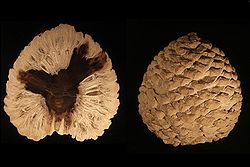
When Charles Darwin wrote On the Origin of Species by Means of Natural Selection, or the Preservation of Favoured Races in the Struggle for Life, the oldest animal fossils were those from the Cambrian Period, now known to be about 540 million years old. The absence of older fossils worried Darwin about the implications for the validity of his theories, but he expressed hope that such fossils would be found, noting that: "only a small portion of the world is known with accuracy." Darwin also pondered the sudden appearance of many groups (i.e. phyla) in the oldest known Cambrian fossiliferous strata.[12]
Further discoveries
Since Darwin's time, the fossil record has been pushed back to between 2.3 and 3.5 billion years before the present.[13] Most of these Precambrian fossils are microscopic bacteria or microfossils. However, macroscopic fossils are now known from the late Proterozoic. The Ediacaran biota (also called Vendian biota) dating from 575 million years ago collectively constitutes a richly diverse assembly of early multicellular eukaryotes.
The fossil record and faunal succession form the basis of the science of biostratigraphy or determining the age of rocks based on the fossils they contain. For the first 150 years of geology, biostratigraphy and superposition were the only means for determining the relative age of rocks. The geologic time scale was developed based on the relative ages of rock strata as determined by the early paleontologists and stratigraphers.
Since the early years of the twentieth century, absolute dating methods, such as radiometric dating (including potassium/argon, argon/argon, uranium series, and, for very recent fossils, carbon-14 dating) have been used to verify the relative ages obtained by fossils and to provide absolute ages for many fossils. Radiometric dating has shown that the earliest known stromatolites are over 3.4 billion years old. Various dating methods have been used and are used today depending on local geology and context, and while there is some variance in the results from these dating methods, nearly all of them provide evidence for a very old Earth, approximately 4.6 billion years.
Modern view
"The fossil record is life's evolutionary epic that unfolded over four billion years as environmental conditions and genetic potential interacted in accordance with natural selection."[14] The earth's climate, tectonics, atmosphere, oceans, and periodic disasters invoked the primary selective pressures on all organisms, which they either adapted to, or they perished with or without leaving descendants. Modern paleontology has joined with evolutionary biology to share the interdisciplinary task of unfolding the tree of life, which inevitably leads backwards in time to the microscopic life of the Precambrian when cell structure and functions evolved. Earth's deep time in the Proterozoic and deeper still in the Archaean is only "recounted by microscopic fossils and subtle chemical signals."[15] Molecular biologists, using phylogenetics, can compare protein amino acid or nucleotide sequence homology (i.e., similarity) to infer taxonomy and evolutionary distances among organisms, but with limited statistical confidence. The study of fossils, on the other hand, can more specifically pinpoint when and in what organism branching occurred in the tree of life. Modern phylogenetics and paleontology work together in the clarification of science's still dim view of the appearance of life and its evolution during deep time on earth.[16]
Niles Eldredge's study of the Phacops trilobite genus supported the hypothesis that modifications to the arrangement of the trilobite's eye lenses proceeded by fits and starts over millions of years during the Devonian.[17] Eldredge's interpretation of the Phacops fossil record was that the aftermaths of the lens changes, but not the rapidly occurring evolutionary process, were fossilized. This and other data led Stephen Jay Gould and Niles Eldredge to publish the seminal paper on punctuated equilibrium in 1971.
Example of modern development
An example of modern paleontological progress is the application of synchrotron X-ray tomographic techniques to early Cambrian bilaterian embryonic microfossils that has recently yielded new insights of metazoan evolution at its earliest stages. The tomography technique provides previously unattainable three-dimensional resolution at the limits of fossilization. Fossils of two enigmatic bilaterians, the worm-like Markuelia and a putative, primitive protostome, Pseudooides, provide a peek at germ layer embryonic development. These 543-million-year-old embryos support the emergence of some aspects of arthropod development earlier than previously thought in the late Proterozoic. The preserved embryos from China and Siberia underwent rapid diagenetic phosphatization resulting in exquisite preservation, including cell structures. This research is a notable example of how knowledge encoded by the fossil record continues to contribute otherwise unattainable information on the emergence and development of life on Earth. For example, the research suggests Markuelia has closest affinity to priapulid worms, and is adjacent to the evolutionary branching of Priapulida, Nematoda and Arthropoda.[18]
Rarity of fossils
Fossilization is an exceptionally rare occurrence, because most components of formerly-living things tend to decompose relatively quickly following death. In order for an organism to be fossilized, the remains normally need to be covered by sediment as soon as possible. However there are exceptions to this, such as if an organism becomes frozen, desiccated, or comes to rest in an anoxic (oxygen-free) environment. There are several different types of fossils and fossilization processes.
Due to the combined effect of taphonomic processes and simple mathematical chance, fossilization tends to favor organisms with hard body parts, those that were widespread, and those that existed for a long time before going extinct. On the other hand, it is very unusual to find fossils of small, soft bodied, geographically restricted and geologically ephemeral organisms, because of their relative rarity and low likelihood of preservation.
Larger specimens (macrofossils) are more often observed, dug up and displayed, although microscopic remains (microfossils) are actually far more common in the fossil record.
Some casual observers have been perplexed by the rarity of transitional species within the fossil record. The conventional explanation for this rarity was given by Darwin, who stated that "the extreme imperfection of the geological record," combined with the short duration and narrow geographical range of transitional species, made it unlikely that many such fossils would be found. Simply put, the conditions under which fossilization takes place are quite rare; and it is highly unlikely that any given organism will leave behind a fossil. Eldredge and Gould developed their theory of punctuated equilibrium in part to explain the pattern of stasis and sudden appearance in the fossil record. Furthermore, in the strictest sense, nearly all fossils are "transitional," due to the improbability that any given fossil represents the absolute termination of an evolutionary path.
Types of preservation
Permineralization
Permineralization occurs after burial, as the empty spaces within an organism (spaces filled with liquid or gas during life) become filled with mineral-rich groundwater and the minerals precipitate from the groundwater, thus occupying the empty spaces. This process can occur in very small spaces, such as within the cell wall of a plant cell. Small scale permineralization can produce very detailed fossils. For permineralization to occur, the organism must become covered by sediment soon after death or soon after the initial decaying process. The degree to which the remains are decayed when covered determines the later details of the fossil. Some fossils consist only of skeletal remains or teeth; other fossils contain traces of skin, feathers or even soft tissues. This is a form of diagenesis.
Casts and molds
In some cases the original remains of the organism have been completely dissolved or otherwise destroyed. When all that is left is an organism-shaped hole in the rock, it is called an external mold. If this hole is later filled with other minerals, it is a cast. An internal mold is formed when sediments or minerals fill the internal cavity of an organism, such as the inside of a bivalve or snail.
Replacement and recrystallization
Replacement occurs when the shell, bone or other tissue is replaced with another mineral. In some cases mineral replacement of the original shell occurs so gradually and at such fine scales that microstructural features are preserved despite the total loss of original material. A shell is said to be recrystallized when the original skeletal compounds are still present but in a different crystal form, as from aragonite to calcite.
Compression fossils
Compression fossils, such as those of fossil ferns, are the result of chemical reduction of the complex organic molecules composing the organism's tissues. In this case the fossil consists of original material, albeit in a geochemically altered state. Often what remains is a carbonaceous film. This chemical change is an expression of diagenesis.
Bioimmuration

Bioimmuration is a type of preservation in which a skeletal organism overgrows or otherwise subsumes another organism, preserving the latter, or an impression of it, within the skeleton.[20] Usually it is a sessile skeletal organism, such as a bryozoan or an oyster, which grows along a substrate, covering other sessile encrusters. Sometimes the bioimmured organism is soft-bodied and is then preserved in negative relief as a kind of external mold. There are also cases where an organism settles on top of a living skeletal organism which grows upwards, preserving the settler in its skeleton. Bioimmuration is known in the fossil record from the Ordovician[21] to the Recent.[20]
To sum up, fossilization processes proceed differently for different kinds of tissues and under different kinds of conditions.
Trace fossils
Trace fossils are the remains of trackways, burrows, bioerosion, eggs and eggshells, nests, droppings and other types of impressions. Fossilized droppings, called coprolites, can give insight into the feeding behavior of animals and can therefore be of great importance.
Microfossils
'Microfossil' is a descriptive term applied to fossilized plants and animals whose size is just at or below the level at which the fossil can be analyzed by the naked eye. A commonly applied cut-off point between "micro" and "macro" fossils is 1 mm, although this is only an approximate guide. Microfossils may either be complete (or near-complete) organisms in themselves (such as the marine plankters foraminifera and coccolithophores) or component parts (such as small teeth or spores) of larger animals or plants. Microfossils are of critical importance as a reservoir of paleoclimate information, and are also commonly used by biostratigraphers to assist in the correlation of rock units.
Resin fossils
Fossil resin (colloquially called amber) is a natural polymer found in many types of strata throughout the world, even the Arctic. The oldest fossil resin dates to the Triassic, though most dates to the Tertiary. The excretion of the resin by certain plants is thought to be an evolutionary adaptation for protection from insects and to seal wounds caused by damage elements. Fossil resin often contains other fossils called inclusions that were captured by the sticky resin. These include bacteria, fungi, other plants, and animals. Animal inclusions are usually small invertebrates, predominantly arthropods such as insects and spiders, and only extremely rarely a vertebrate such as a small lizard. Preservation of inclusions can be exquisite, including small fragments of DNA.
Pseudofossils

Pseudofossils are visual patterns in rocks that are produced by naturally occurring geologic processes rather than biologic processes. They can easily be mistaken for real fossils. Some pseudofossils, such as dendrites, are formed by naturally occurring fissures in the rock that get filled up by percolating minerals. Other types of pseudofossils are kidney ore (round shapes in iron ore) and moss agates, which look like moss or plant leaves. Concretions, spherical or ovoid-shaped nodules found in some sedimentary strata, were once thought to be dinosaur eggs, and are often mistaken for fossils as well.
Living fossils
Living fossil is an informal term used for any living species which is apparently identical or closely resembles a species previously known only from fossils'that is, it is as if the ancient fossil had "come to life."
This can be (a) a species or taxon known only from fossils until living representatives were discovered, such as the lobe-finned coelacanth, primitive monoplacophoran mollusk, and the Chinese maidenhair tree, or (b) a single living species with no close relatives, such as the New Caledonian Kagu, or the Sunbittern, or (c) a small group of closely-related species with no other close relatives, such as the oxygen-producing, primordial stromatolite, inarticulate lampshell Lingula, many-chambered pearly Nautilus, rootless whisk fern, armored horseshoe crab, and dinosaur-like tuatara that are the sole survivors of a once large and widespread group in the fossil record.
See also
- Bioerosion
- Coprolite
- Cryptospores
- Elvis taxon
- Fossil collecting
- History of paleontology
- Ichnology
- Lazarus taxon
- List of extant animal genera represented in the fossil record
- List of fossil sites
- List of fossils
- List of transitional fossils
- Paleobiology
- Paleobotany
- Petrification
- Shark teeth
- Subfossil
- Taphonomy
- Trace fossil
- Fossil trade
References
- ^ Frequently Asked Questions about Paleontology. San Diego Natural History Museum
- ^ Westall, Frances; et al. (2001). "Early Archean fossil bacteria and biofilms in hydrothermally-influenced sediments from the Barberton greenstone belt, South Africa". Precambrian Research 106 (1-2): 93'116. doi:10.1016/S0301-9268(00)00127-3. http://ieg.or.kr:8080/abstractII/E0210601006.html.
- ^ "Stromatolites, the Oldest Fossils". http://www.fossilmuseum.net/Tree_of_Life/Stromatolites.htm. Retrieved 2007-03-04.
- ^ Knoll, A. H., Barghorn, E.S, Awramik, S.M,. (1978). New organisms from the Aphebian Gunflint Iron Formation. Journal of Paleontology(52), 1074-1082.
- ^ Lowe, D. R. (1994). Abiological origin of described stromatolites older than 3.2 Ga. Geology, 22, 387-390
- ^ Correlating Earth's History, Paul R. Janke
- ^ Intute Timeline - Fossils (Subject: Science Engineering and Technology)
- ^ Rudwick, M. J. S. (1985). The Meaning of Fossils: Episodes in the History of Palaeontology. University of Chicago Press. p. 24. ISBN 0226731030
- ^ Alistair Cameron Crombie (1990). Science, optics, and music in medieval and early modern thought. Continuum International Publishing Group. pp. 108'109. ISBN 0907628796.
- ^ da Vinci, Leonardo (1938/1956). The Notebooks of Leonardo Da Vinci. London: Reynal & Hitchcock. p. 335. ISBN (OCLC) 67650193. http://books.google.com/?id=qMoQAAAAIAAJ&q=%22If+the+Deluge+had+carried%22&dq=%22If+the+Deluge+had+carried%22.
- ^ Georges Cuvier - Fossil discoveries
- ^ Darwin, C (1859) On the Origin of Species. Chapter 10: On the Imperfection of the Geological Record.
- ^ Schopf JW (1999) Cradle of Life: The Discovery of the Earth's Earliest Fossils, Princeton University Press, Princeton, NJ.
- ^ "The Virtual Fossil Museum - Fossils Across Geological Time and Evolution". http://www.fossilmuseum.net/. Retrieved 2007-03-04.
- ^ Knoll, A, (2003) Life on a Young Planet. (Princeton University Press, Princeton, NJ)
- ^ Paul CRC and Donovan SK, (1998) An overview of the completeness of the fossil record. in The Adequacy of the Fossil Record (Paul CRC and Donovan SK eds). 111-131 (John Wiley, New York).
- ^ Fortey R, Trilobite!: Eyewitness to Evolution. Alfred A. Knopf, New York, 2000.
- ^ Donoghue, PCJ, Bengtson, S, Dong, X, Gostling NJ, Huldtgren, T, Cunningham, JA, Yin, C, Yue, Z, Peng, F and Stampanoni, M (2006) Synchrotron X-ray tomographic microscopy of fossil embryos. Nature 442, 680-683
- ^ Palmer, TJ, and Wilson, MA (1988) Parasitism of Ordovician bryozoans and the origin of pseudoborings. Palaeontology 31,939-949
- ^ a b Taylor, PD. (1990) Preservation of soft-bodied and other organisms by bioimmuration: A review. Palaeontology 33,1-17
- ^ Wilson, MA, Palmer, TJ and Taylor, PD (1994) Earliest preservation of soft-bodied fossils by epibiont bioimmuration: Upper Ordovician of Kentucky. Lethaia 27, 269-270
Further reading
- It's extremely hard to become a fossil, writes Olivia Judson at the New York Times
- Bones Are Not the Only Fossils, by Olivia Judson at the New York Times
External links
| Look up fossil in Wiktionary, the free dictionary. |
| Wikimedia Commons has media related to: fossils |
- The Virtual Fossil Museum throughout Time and Evolution
- Paleoportal, geology and fossils of the United States
- Palaeos, a multi-authored wiki encyclopedia on the history of life on Earth
- The Fossil Record, a complete listing of the families, orders, class and phyla found in the fossil record
- Bioerosion website, including fossil record
- Fossil record of life in the Coal Age
- Fossil Wiki - a wiki-based encyclopaedia on fossils
|
SOURCES.COM is an online portal and directory for journalists, news media, researchers and anyone seeking experts, spokespersons, and reliable information resources. Use SOURCES.COM to find experts, media contacts, news releases, background information, scientists, officials, speakers, newsmakers, spokespeople, talk show guests, story ideas, research studies, databases, universities, associations and NGOs, businesses, government spokespeople. Indexing and search applications by Ulli Diemer and Chris DeFreitas.
For information about being included in SOURCES as a expert or spokesperson see the FAQ . For partnerships, content and applications, and domain name opportunities contact us.


